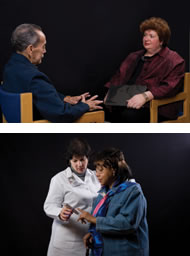Featured Initiative:

Virtual Integrated Practice Model:
Building Community Capacity
Dr. Rothschild and the group at Rush are using funds from the dissemination of GIT-P grant to develop materials to aid in the dissemination of the model to primary care practices. They have developed a VIP handbook and a Web site (www.rush.edu/professionals/vip/). They are also creating a train the trainer program. While discussions are underway with several health organizations and health insurance plans about adoption of the model, some organizations have already incorporated aspects of the model in their own team care projects.
As he began developing a pilot program in San Diego County for a
coordinated, low-cost team approach to chronic illness care, Mark
Meiners, PhD, George Mason University professor of health policy,
learned of the VIP model and contacted Dr. Rothschild. When he first
wrote the grant for the program, called "Team San Diego," Dr. Meiners
used the term "virtual teaming," not knowing at the time that the idea
of virtual teams was already being applied to the care of chronically
ill patients.
“Virtual team care introduces formality to things that are happening
but in a haphazard and unsystematic way. By formalizing the team,
chances of improving care are increased significantly.”Mark Meiners, PhD
Professor of Health Policy
George Mason University
Fairfax, Virginia and
National Program Director
Medicare/Medicaid Integration Program, sponsored by the Robert Wood
Johnson Foundation
Dr. Rothschild shared the VIP materials with Dr. Meiners, which he is now using to help develop the training, delivery, and evaluation methods for the Team San Diego project. "Virtual team care introduces formality to things that are happening but in a haphazard way," says Dr. Meiners. "By formalizing it the chances of improving care are increased significantly."
Dr. Rothschild and the group at Rush are also overseeing curriculum development as part of a broad initiative to expand the availability of Programs of All-Inclusive Care for the Elderly (PACE) across the United States. PACE, which has been supported by the Foundation since its earliest days, makes it possible for older adults to avoid nursing home placement and receive coordinated medical and social services, enabling them to age in their communities. It is a comprehensive, integrated health care plus financing model. The VIP team will build an on-line curriculum for Rural PACE. The National PACE Association has expressed interest in using the curriculum for urban settings as well.
 (Above) Social worker, Robyn L. Golden, LCSW, with patient.
(Above) Social worker, Robyn L. Golden, LCSW, with patient.
(Below) Catherine Catrambone, PhD, RN, explaining peak flow monitoring
for asthma management.
Other organizations that have consulted with the VIP team include Blue
Cross of Illinois, Chicago Department on Aging (CDC Hispanic Elders
Initiative), Chicago Department of Public Health, and the Illinois
Department on Aging.
Validation from the Hartford effort was very important for
co-investigators Robyn Golden and Stan Lapidos in their successful
application to the Retirement Research Foundation. Awarded $203,234
over three years in 2006, project BRIGHTEN expands on the virtual team
model to improve the identification and treatment of depression in
primary care settings. Equally important has been the role of the
Foundation in opening doors. The Hartford "imprimatur" is recognized
for its high standards in quality care of older adults. As the team at
Rush talks to physicians, hospitals, and professional societies, the
John A. Hartford Foundation has been an important door opener.
Next: VIP: A Seamless System of Resources ›
